
MV Agusta 1945-77 (1981), 1997 – Italy
Record books, encyclopaedias and race marque enthusiasts tell us MV Agusta secured 38 riders’ World Championships, 37 manufacturers’ world titles and more than 4000 national and international race wins. Nicknamed the ‘Red Fire Engines’ by many, their list of World Championship-winning riders reads like a Who’s Who of road racing with Giacomo Agostini (350cc – 1968-73 inclusive; 500cc – 1966-72 inclusive), Mike Hailwood (500cc 1962-65 inclusive), Gary Hocking (350cc – 1961, 500cc – 1961), Tarquinio Provini (250cc 1958), Phil Read (500cc 1973-74), Cecil Sandford (125cc 1952), John Surtees (350cc 1958-60; 500cc 1956, 1958-60), Carlo Ubbiali, (125cc 1955-56, 1958-60; 250cc 1956, 1959-60).
These and many more awesome statistics could serve in our minds to put the marque beyond our reach, as something only for those with endless contacts or bottomless pockets. True, surviving ‘works’ racers change hands for mega-money and the price of 125cc sohc over-the-counter racers makes the average BSA Gold Star a bargain, but the smaller roadsters are quite affordable. True, they won’t win World Championships, leap a yard high at Ballaugh Bridge or trouble motorway speed cameras, but they are a great opportunity to own an attractive, well-made link with one of the greatest racing stables ever.
Passionate Italian enthusiasts regard MV Agusta as their Ferrari on two wheels. Yet, despite all, aircraft not motorcycles were and, after a break, still are the company’s main business. Founded in 1945 by the wealthy aircraft and aircraft parts manufacturer, the Sicilian aristocrat Count Domenico Agusta, to cash in on a need for economical personal transport, MV – Meccanica Verghera (Verghera is the company’s home village near Milan) – production began with a three-speed 98cc two-stroke single which might have been called the ‘Vespa.’
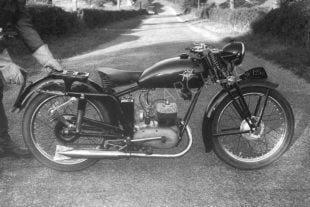 In common with other Italian motorcycle factory proprietors, Agusta didn’t wait too long before wanting to prove his motorcycles were quicker than those of his rivals. In 1948 MV unveiled their first racer, a four-speed 125cc two-stroke single. With hindsight it seems fitting the great Carlo Ubbiali scored MV’s first points in the first 125cc World Championship round at Berne, Switzerland, on 3 July 1949. Although his lightweights were outclassed by the dohc FB Mondials, Count Domenico rapidly gained a love of racing which was to be a passion until his death in 1971.
In common with other Italian motorcycle factory proprietors, Agusta didn’t wait too long before wanting to prove his motorcycles were quicker than those of his rivals. In 1948 MV unveiled their first racer, a four-speed 125cc two-stroke single. With hindsight it seems fitting the great Carlo Ubbiali scored MV’s first points in the first 125cc World Championship round at Berne, Switzerland, on 3 July 1949. Although his lightweights were outclassed by the dohc FB Mondials, Count Domenico rapidly gained a love of racing which was to be a passion until his death in 1971.
Within months of Ubbiali’s fourth at Berne, followed by a third at Assen, the Count had tempted Ingegnere Pietro Remor and Arturo Magni away from Gilera. Remor designed the 125cc dohc single and 500cc dohc four; ideas Magni soon developed into running motorcycles. After some ill-planned ambitious press announcements and false alarms, MV Agusta’s 290lb 500/4 finally made the start line at Spa-Francorchamps on 2 July 1950. In an event during which an accident ended the racing career of Artie Bell, Gilera ace Umberto Masetti (1950-52 500cc World Champion) won at over 100mph with MV’s Arciso Artesiani placed fifth.
Although both the 125cc and 500cc GP racers were to undergo major engine and chassis development over the next couple of years, the company from Verghera were on their way helped in no small measure when 1949 500cc World Champion Les Graham left AJS to join them. Graham soon became the father figure of the team, able to guide fellow-riders and assist with development input. Englishman Cecil Sandford earned the distinction of winning MV’s first World Championship title, in the 1952 125cc class with wins in the Isle of Man, Ulster GP and Dutch GP at Assen.
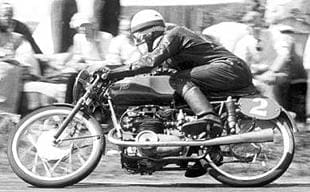 Despite all the racing development, neither roadsters nor scooters (which are covered in the sidebar) were forgotten. In 1950 the R19 four-cylinder 500cc roadster was unveiled but never went into production. The Count feared able engineers could develop the street machine into a rapid racer which could challenge his works machines in national and possibly international events, a chance he wasn’t prepared to take. Towards the close of 1952, MV Agusta expanded their range to include a 172.3cc ohc single engine which was found in a number of models including the Disco Volante (flying saucer) sports roadster and Squale (shark) road racer.
Despite all the racing development, neither roadsters nor scooters (which are covered in the sidebar) were forgotten. In 1950 the R19 four-cylinder 500cc roadster was unveiled but never went into production. The Count feared able engineers could develop the street machine into a rapid racer which could challenge his works machines in national and possibly international events, a chance he wasn’t prepared to take. Towards the close of 1952, MV Agusta expanded their range to include a 172.3cc ohc single engine which was found in a number of models including the Disco Volante (flying saucer) sports roadster and Squale (shark) road racer.
An attractive sohc 125cc single over-the-counter racer went on offer, an ideal clubmen’s mount, which was used to good effect by privateer placemen in GPs, too. But it was no match for the dohc works models ridden by the top riders of the period. Also, a new ohv engine was developed for roadster production – first as a 123.6cc single in 1954, then 246.6cc single in 1956 followed by a wide array of 83.2cc to 301cc singles and 147cc twins to the 348.9cc parallel twin introduced in 1970.
Through the efforts of the full race team, and leading riders headed by Carlo Ubbiali and John Surtees, MV Agusta ruled the world on the GP circuit as the Fifties drew to a close. It was a meteoric rise to world racing recognition and then domination culminating in a hat-trick of grand slams of the then four solo GP titles; 1958 Ubbiali 125cc, Tarquinio Provini 250cc and Surtees 350/500cc, 1959 and 1960 Ubbiali 125/250cc and Surtees 350/500cc. Despite this enviable track success MV roadster sales, in common with rival Italian factories, were plummeting owing to the rise in popularity and affordability of the small car. With brilliant foresight MV returned in part to the aircraft industry, initially under a licence agreement with Bell helicopters.
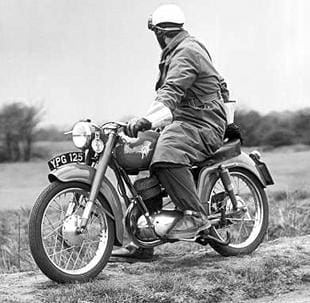 Carlo Ubbiali retired at the close of the 1960 season. His father had died and, as the oldest son, it fell to Carlo to take over as head of the family and run their engineering business. MV dropped out of the 125/250cc classes but continued to support the 350/500cc categories. However, after Gary Hocking’s 1961 350/500cc double, the ageing 350cc four was rapidly outclassed by the overbored 250cc four Hondas, then later the six. Ironically MV had earlier built a six, too, but then abandoned the idea.
Carlo Ubbiali retired at the close of the 1960 season. His father had died and, as the oldest son, it fell to Carlo to take over as head of the family and run their engineering business. MV dropped out of the 125/250cc classes but continued to support the 350/500cc categories. However, after Gary Hocking’s 1961 350/500cc double, the ageing 350cc four was rapidly outclassed by the overbored 250cc four Hondas, then later the six. Ironically MV had earlier built a six, too, but then abandoned the idea.
MV continued in the 500cc class with four consecutive titles for Mike Hailwood, whose only serious challengers were Matchless-mounted Alan Shepherd, the Nortons of Jack Ahearn/Phil Read (1962), the ageing Gileras of John Hartle/Phil Read (1963) and finally a new youngster on the block from Brescia, Giacomo Agostini, in 1965. The same year, MV had their new generation of three-cylinder racers competitive, and the legendary partnership between MV Agusta and Ago’ was cemented as he gave the 350cc three its first win at the West German GP in 1965.
Finally, in late 1965, Count Agusta permitted the manufacture of a four-cylinder roadster. The angular, slow-selling 591.8cc Quattro was followed by the attractive 750S unveiled at the 1969 Milan Show and later developed into the touring 750GT, sporting 750SS, 750 America (789cc) and 850 Monza (837cc). Count Domenico Agusta died in 1971, leaving Corrido Agusta to head his firm.
Arturo Magni and designer Ruggero Mazza were able to keep the four-stroke MV Agustas ahead of what was rapidly becoming the two-stroke game thanks, in part, to the skilful riding of Agostini until he switched to Yamaha for the 1974 season and the superb tactical racecraft of Phil Read, who secured the 1973 and 1974 500cc titles for MV. Finally the four-strokes were defeated in the 500cc class, the rising two-stroke challenge with Ago’s Yamaha taking the 1975 title from Read’s MV.
 Due in part to Italian Government direction and contracts, MV Agusta focused more and more on their aviation business, becoming leading builders of helicopters. Motorcycle production ended in 1977-78, although new machines were available from the stock until 1981. In 1992 the Castiglioni brothers – owners/founders of Cagiva – bought the MV Agusta name and began developing a new four-cylinder engine in conjunction with Ferrari, which proved costly. Owing to a variety of problems, the project was put on hold until the funds became available after the sale of Ducati in 1997. Massimo Tamburini, who designed the Ducati 916, took over the project leading to the unveiling of the F4 at the 1997 Milan Show. In 1999, Cagiva announced they were changing their company name to MV Agusta, although they retained their Cagiva badge. More recently, the MV trade name changed hands again, with the giant Malaysian Proton concern buying the famous moniker.
Due in part to Italian Government direction and contracts, MV Agusta focused more and more on their aviation business, becoming leading builders of helicopters. Motorcycle production ended in 1977-78, although new machines were available from the stock until 1981. In 1992 the Castiglioni brothers – owners/founders of Cagiva – bought the MV Agusta name and began developing a new four-cylinder engine in conjunction with Ferrari, which proved costly. Owing to a variety of problems, the project was put on hold until the funds became available after the sale of Ducati in 1997. Massimo Tamburini, who designed the Ducati 916, took over the project leading to the unveiling of the F4 at the 1997 Milan Show. In 1999, Cagiva announced they were changing their company name to MV Agusta, although they retained their Cagiva badge. More recently, the MV trade name changed hands again, with the giant Malaysian Proton concern buying the famous moniker.
At the time Count Agusta was regrouping his company after WWII and switching from aviation to motorcycles over in Tuscany, Enrico Piaggio was planning a future on two wheels too – albeit small wheels. Agusta planned to call his new machine the MV Vespa but was thwarted. Enrico had already registered the name Vespa (Wasp) for his scooter, which went on to worldwide fame. Both businessmen fancied the name for the insect’s buzzing sound, representative of the small two-stroke engine rather than the suggestion of some past writers who link it to the Roman emperor Titus Flavius Sabinis Vespasianus.
MV Agusta scooter production began with the 125cc single-cylinder two-stroke model B of 1949. It was followed in 1950 by the 125cc Popolare basic economy scooter, renamed the Normale in 1951 and the CGT or C Gran Turismo in 1952. The CGT was also offered with a 150cc engine and then replaced by the Ovunque (Everywhere), which continued until 1954. A more enclosed scooter loosely based on Model B lines was also unveiled in 1950 called the Model C, which became the CSL or C Super Lusso in 1951.
 Although MV Agusta also made mopeds and three-wheeled trade vehicles, scooter production was abandoned in the mid-Fifties until 1960 when the 166cc four-stroke Bik and 155cc two-stroke Chicco were unveiled. The Bik never went into production but the Chicco, which some claim looks like the Vespa (although, other than having small wheels and enclosed bodywork I can’t see many similarities), remained in production until 1964 when scooters were dropped for good.
Although MV Agusta also made mopeds and three-wheeled trade vehicles, scooter production was abandoned in the mid-Fifties until 1960 when the 166cc four-stroke Bik and 155cc two-stroke Chicco were unveiled. The Bik never went into production but the Chicco, which some claim looks like the Vespa (although, other than having small wheels and enclosed bodywork I can’t see many similarities), remained in production until 1964 when scooters were dropped for good.
Although well-made, some MV Agusta lightweights are ordinary but pleasant motorcycles. However, MV’s illustrious track record results in proportionally higher prices than for comparable machines from other marques. Viewed from another angle they afford a relatively-inexpensive link with one of the greatest racing factories of all time. For those with excessively deep pockets surviving works racers surface, but check provenance as dubious ringers are reputed to have been made and honest replicas are occasionally available, which is fine as we all respect them for what they are.
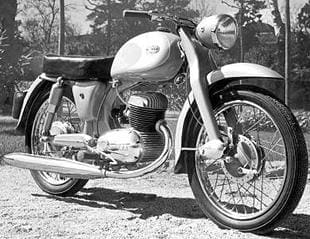 Mymsa 1953-62 Spain
Mymsa 1953-62 Spain
Manufactured a wide range of 75-175cc models usually with single-cylinder two-stroke engines. Although the firm’s output was low, there are survivors.
MZ (MuZ) 1953 – Germany
Motorradwerke Zschopau (Zschopau Motorcycle Works) surfaced in 1953, as engineer Walter Kaaden founded the MZ Sport workshop to build and develop road-racing and off-road competition motorcycles. Yet the factory’s roots stretch back to 1919. Jorgen Stafte Rasmussen, born at Nakskow, Denmark in 1898, moved to Dusseldorf in 1904 and Zschopau three years later where, in 1919, he founded his company JS Rasmussen, to develop and build steam engine units for cars under the name DKW. In 1921, Hugo Ruppe designed 122cc two-stroke clip-on units for the Zschopau company.
Selling in big numbers, the auxiliary motor was followed by some slow selling scooters, then a series of superb motorcycles designed in conjunction with Ruppe. During the 1930s, DKW were large volume motorcycle makers, even beating BSA on occasions. Racing, off road competition and roadster production success came to an end during WWII. But not before the Hermann Webber designed RT125 military lightweight was built, which became the world’s most copied motorcycle.
With their severely damaged factory at Zschopau in the eastern zone under communist control after WWII, DKW established a new production line in Ingolstadt, Bavaria. The controlling Soviet Military Administration ordered the dismantling and rebuilding of the former DKW works at Zschopau, while motorcycle production of civilian RT125s began at Wilischthal.
In 1948 IFA (Industrieverband-Farhzeugebau) assumed ownership of the plant under the Communist regime nationalisation programme, with production moving back to Zschopau in 1951. A year later the plant launched the shaft drive flat twin BK350 which, although a two-stroke, looked uncannily like a BMW, but with DKW two-stroke cylinder barrels and heads instead of the familiar BMW pushrod set-up.
 Taking what were little more than roadsters with revised gearing and competition tyres, or racers derived from stripped roadsters, the first ‘works’ machines entered the competition world. They were outclassed, but not for long. Kaaden was soon using disc valve induction with thin spring steel discs, instead of the thick cast iron discs used by earlier marques, including the Sun Vitesse. By 1955 Kaaden’s 125cc two-strokes, dismissed as ‘no hopers’ two-years earlier, were dishing out 15bhp, enough for 95mph. By the late 1950s the figure was 20bhp, then 23bhp@10,700rpm in 1960 and 25bhp from the 123.6cc two-stroke a year later. It was a 120mph lightweight and the first internal combustion engine to break the 200bhp/litre barrier.
Taking what were little more than roadsters with revised gearing and competition tyres, or racers derived from stripped roadsters, the first ‘works’ machines entered the competition world. They were outclassed, but not for long. Kaaden was soon using disc valve induction with thin spring steel discs, instead of the thick cast iron discs used by earlier marques, including the Sun Vitesse. By 1955 Kaaden’s 125cc two-strokes, dismissed as ‘no hopers’ two-years earlier, were dishing out 15bhp, enough for 95mph. By the late 1950s the figure was 20bhp, then 23bhp@10,700rpm in 1960 and 25bhp from the 123.6cc two-stroke a year later. It was a 120mph lightweight and the first internal combustion engine to break the 200bhp/litre barrier.
Back on the roadster front, IFA built over 60,000 IFA RT125 and TR125/1 125s before the model was updated to become the MZ RT125/2 in 1956, of which 55,424 were built in three years, followed by 143,035 MZ RT125/3s during 1959-62. The model, updated again, became the MZ ES125 in 1962, when the top selling ES150 was launched. The ES125/1 was replaced by the TS125 series in 1973, at which time the TS150 was launched too although the ES150 range, updated to the /1 in 1969, continued until 1978.
MZ had upped its market share back in 1956 by launching the 171.7cc ES175 and 250.1cc ES250 which, like the 125s, were built in large volume. The 293.1cc ES300 appeared in 1963, but was a slow seller by MZ standards. In 1967 the bore of the 250cc range was reduced from 70mm to 69mm, giving the more familiar 243.1cc and in 1976 a five speed gearbox was fitted for the first time, creating the MZ250/1.
Although despised by many, MZ – or at least Walter Kaaden – was the most influential force in post WWII two-stroke development. Kaaden’s work on porting, port bridging, disc valves, port timing and calculated expansion chamber volume dependent on port timing as well as engine capacity, was cutting edge. Much of his work went to Japan in 1961 with the defection of MZ works rider Ernst Degner to Suzuki, an act which possibly robbed the East German factory of the year’s rider’s title.
MZ notched up their first 125cc World Championship points in 1957, with Horst Fugner fourth and Degner sixth at Hockenheim. Their first GP win came a year later in the 250cc race at Hedemora, Sweden. A succession of top names rode MZ raceware including Mike Hailwood, Gary Hocking, Alan Shepherd, Derek Woodman, Jan Huberts, Derek Minter, Dieter Braun… Sadly world championships were never to be theirs, due in part to competing with a cash strapped team against the might of Honda, Suzuki and Yamaha.
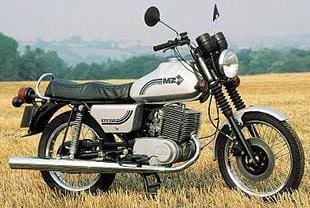 Often a strong off-road team, notably in ISDT events, MZ gradually slid from the sporting world but continued with roadster production, including the updated ETZ250 in 1981 and ETZ125 (Saxon Roadster) in 1985. Although out of our period, the end of Communist control spelt the end of MZ two-stroke motorcycles despite production moving to Turkey, while West German influence saw the MZ label, now as MuZ, grace a range of 500-650cc single cylinder tourers and sportsbikes. Production of these continues today, along with a couple of scooters and a 1000cc parallel twin.
Often a strong off-road team, notably in ISDT events, MZ gradually slid from the sporting world but continued with roadster production, including the updated ETZ250 in 1981 and ETZ125 (Saxon Roadster) in 1985. Although out of our period, the end of Communist control spelt the end of MZ two-stroke motorcycles despite production moving to Turkey, while West German influence saw the MZ label, now as MuZ, grace a range of 500-650cc single cylinder tourers and sportsbikes. Production of these continues today, along with a couple of scooters and a 1000cc parallel twin.
Loved or loathed, much enthusiasm exists for MZs of all persuasions, including racers, off-roaders and roadsters. Clubs and spares are at hand to help.



